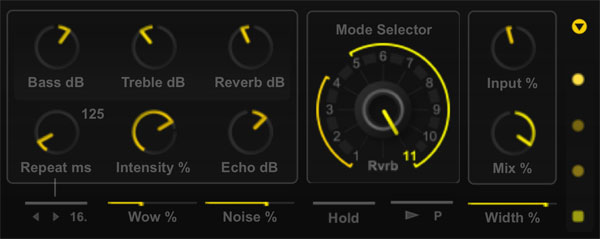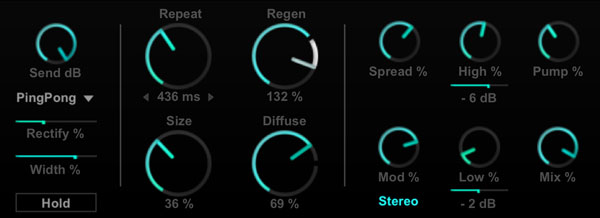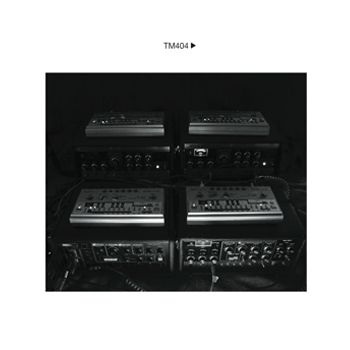Can an echo of the old still bring something new?
Dub Machines, an Ableton Live pack of delay Devices, is both a painstaking set of digital models of analog delays and a chance to open those old techniques to new possibilities. And its unique flavor is in no small measure thanks to its creators. We got to talk to Matt Jackson (Ableton) about this new endeavor and how it came about – and some of the stories inside its creation, including the involvement of one of our favorite machine music makers, TM404.
First, though, about those machines. Developer Surreal Machines won’t say it, but I will: yes, one of them is based on the Roland Space Echo (and Korg’s Stage Echo, for good measure). Yet I’m still pleased to try out another Space Echo emulation – even having used one of my favorites, Universal Audio’s model, just a few hours ago – because there is a new take on that classic (and that’s even before it gets remixed into a second device, but more on that in a moment).
Magnetic is obviously a model of that classic, reborn in Max for Live. And with hardware renowned for its non-linearity, that gave them a lot of work – measuring, sampling, listening. There are a couple of things they’ve done that are interesting. They sampled noise directly, and then did a kind of mechanical sampling – measuring Wow and Flutter on the delay itself. The spring reverb is recreated using convolution.

If you were TM404, this would be what your studio would look like. The team went to Södermalm to sample and measure this gear. You … might recognize some of it, by the clear lettering on the front panels that says what it is.
Then they began working outside of what the Roland and Korg units can do. There are imperfections now in the digital domain, in stereo shift and modulation, creating unexpected phasing on-demand. (Hey, no one said analog gear had a monopoly on nonlinearity or unexpected results.) They added additional samples to the convolution reverb – plates, digital halls, an amp, a cardboard box. They added additional routing for the reverb – pre- and post- echo. There are new reverse options, and new machine “styles.” The result is a more flexible, broader device, a reimagining as well as a recreation of the original.
Diffuse uses digital feedback network techniques, which is what early digital delays and reverbs employed for both those effects. By breaking out the modules into useful controls, you can directly access those options. (You’ll see the DNA – and potentially results – of everything from Lexicon to MXR to Roland in there, in uniquely-combinable ways.)
Back to the twists: Pump, sidechain compression/ducking, and Rectify.
You need Max for Live and Live 9 – so, most likely, we’re talking Live Suite here – but once you’ve got it, the pack is just 29€.
Matt wrote some other comments for us on the back story of these effects and the team that created them.
It’s a new endeavor – even with a product lead from Ableton. “It’s important to note that although I’m the product designer for the instruments and effects at Ableton, this is a completely independent company,” Matt tells us.
The code is build in gen~. Max’s low-level DSP language can export to C++. That means these effects – and future effects – won’t necessarily be limited to Max for Live. Alex Harker’s convolution external gets some action, too, the same ingredient in the excellent Max for Live convolution reverbs now in Live 9 (which Matt also worked on).
You can get inside the Max patches. It’s “open” not in a strict sense, but you can open and modify the patches; there’s nothing to stop you. (I’d like to see a proper license on these things so people know what’s expected, but at least you can tinker.) “There’s no real license around how it can be reused and even the copy protection is very light,” says Matt. He notes that whereas Reaktor Player now protects any derived ensemble files under the same copy protection key, that isn’t yet the case with Max for Live.
The guy behind some of the instruments and effects you know. Matt Jackson also tells us a bit about his background:
I was a product designer for Reaktor Player and also did product design for all the Reaktor player instruments until Monark (Spark, Finger, Mouth, Lazerbass and Razor; as well as Absynth and Guitar Rig and now the Ableton Devices). Also I’m a bit of a convolution freak. The first convolution reverb I designed was Reflektor for Guitar rig (later Little Reflektor and Vintage Verb), but also was the product designer for the Max for Live convolution Reverb suite in Live 9 suite, along with the developer Alex Harker from Huddersfield. Magnetic uses this same engine, so it’s also a cool example of how publicly released devices can share code. Also cool that convolution is possible in Max and not yet in Reaktor.
Pete Dowling chimes in, collaborating with Matt from a different corner of the world:
..recently, everything from mixing and mastering short films for Clara Ursiti and Deniz Uster to doing multicsreen gallery installations for artist Rob Kennedy to doing all the live electronics and software work for composer David Fennesy. It is a real mixed bag and has taken me to galleries and venues all over the place, as well ongoing working relationships with lots of interesting institutions such as ‘Panel’ and ‘The People Show’ and doing sound for choreographer Trajal Harrell. my favourite thing to do though is to sit at home on my butt writing gen~ code.
And Matt shares how Andreas Tilliander, aka our hero TM404, contributed to the devices:
The devices were done in cooperation with my old friend Andreas Tilliander (akak TM404). I used to tour with him in 2002 when he was on Mille Plateaux and raster Norton as Mokira. To really get the detail of the RE-201 and we had Andreas measure his delays and send us files from his studio in Södermalm, Stockholm. He was so generous, he not only measured his 201 but also 200, 301, 501 and Stage Echo which we studied and used to make new classic modes. The samples of the noise in Magnetic are actually sampled from the same delays that are used on his album and featured on the cover.
Check out the instruments at Ableton:
Dub Machines: Analog Echos for Live
Dub Machines [Ableton Store]
Listen in on the creators in the Art + Music + Technology podcast:
Podcast 030: Pete Dowling and Matt Jackson
And on their site:
http://www.surrealmachines.com/


